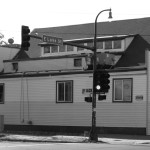- Burma-Vita moved into 2019 East Lake Street in 1925. Built in 1900, the building had once been home to Hugnad Hall, a Scandinavian workingman”'s lodge, and then the Winget Mfg. Co.making aprons, sunbonnets, and dust caps.
- The same building today after many different owners and occupants. The building has had a variety of cosmetic coverings that conceal the original exterior in the photo on the left. A Museum of the Streets plague describes the building across the street near the YWCA.
BY SHARI ALBERS
Burma-Shave and its iconic signage was at 2019 East Lake Street
Remember when highway speed limits were 55 miles per hour and billboards were not common sights? Many of us who grew up in the 40s and 50s may recall the sequenced red and white signs that once dotted the roadway landscape. Positioned one hundred paces apart, each sign displayed one line of verse. Together, the signs created a whole poem. The last sign, like a well-placed exclamation mark, sported the familiar Burma-Shave logo.
She eyed/his beard/and said no dice/the wedding”'s off/I”'ll cook the rice/Burma-Shave
Use this cream/a day/or two/then don”'t call her””/she”'ll call you/Burma-Shave
Past/schoolhouses/take it slow/let the little shavers grow/Burma-Shave (1940s)
Clinton M. Odell”'s father developed a recipe for a pain soothing liniment. The product, called Burma-Vita, never sold well. Young Clinton, a successful insurance salesman with a law degree from the U of M, commissioned a chemist to further develop the liniment into a brushless shaving cream. They called it Burma-Shave.
Burma-Vita moved into 2019 East Lake Street in 1925. Built in 1900, the building had once been home to Hugnad Hall, a Scandinavian workingman”'s association, and then the Winget Manufacturing Company where workers fabricated aprons, sunbonnets, and dust caps. While Burma-Vita produced Burma-Shave, its historic advertising campaign took shape around the same time the company moved to this East Lake Street location.
Clinton”'s sons Allan and Leonard were hawking the products door-to-door, when Allan found advertising inspiration along a road in Illinois. A gas station had erected a series of signs that led onlookers to its location. The growing popularity of the automobile had people criss-crossing America along new highways, and Allan saw marketing promise.
Allan and Leonard cut recycled wood into 36” lengths and hand-stenciled the first red and white signs. Erected on Highway 35 between Minneapolis and Albert Lea, the first series of signs eventually grew to 7000 all across America. Customers demanded the product. Drug stores along the sign routes stocked Burma-Shave on their shelves. It was said that Burma-Vita was one company that did not lose money during the Depression.
At some point, the Odells began to rhyme the sign messages and created national contests to solicit new jingles. Rhyme contests brought in thousands of entries each year. $100 was paid for each verse used. Some years, there were 50,000 entries. Farmers along highways eagerly claimed extra income as they rented stretches of land for Burma-Shave signage.
To kiss/a mug/that”'s like a cactus/takes more nerve/than it does practice/Burma-Shave
We”'re widely read/and often/quoted/but it”'s shaves/not signs/for which we”'re noted/Burma-Shave (1953)
Slow down, Pa/sakes alive/Ma missed signs four/and five/Burma-Shave (1955)
Around 1935, the Odells moved their Burma-Vita business to a larger facility in Bryn Mawr neighborhood. Phillip Morris Co. purchased Burma-Vita in 1963, eventually phasing out its products and signature advertising campaign. Today, a few Burma-Shave signs are said to be seen at gas stations, taverns, and county museums. The Smithsonian Institute exhibits some signs in its Popular Culture division.
If you don”'t know/whose signs/these are/you haven”'t driven/very far/Burma-Shave
The wolf/is shaved/so neat and trim/Red Riding Hood/is chasing him/Burma-Shave
The bearded lady/tried a jar/She”'s now/a famous/movie star/Burma-Shave











